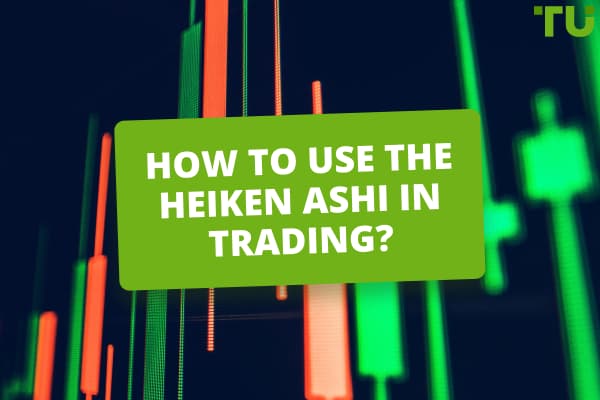Top 7 Day Trading And Scalping Indicators On TradingView
The best TradingView indicators for day trading with high accuracy rates are:
TradingView offers an array of effective tools designed for day traders seeking enhanced decision-making capabilities. These tools help them in trend identification, momentum assessment, volatility tracking, and market participation insights. Additionally, there are tools that help evaluate trend strength, support, resistance, and fair value. When strategically combined and considered within the broader market context, these tools provide invaluable assistance in making informed and timely day trading decisions. So, for traders looking to capitalize on the platform’s capabilities, the experts at TU have in this article discussed 7 best day trading and scalping indicators TradingView has to offer. They have also discussed their key features and entry and exit points to provide a holistic overview for traders who wish to incorporate them into their trading strategies.
Bollinger Bands
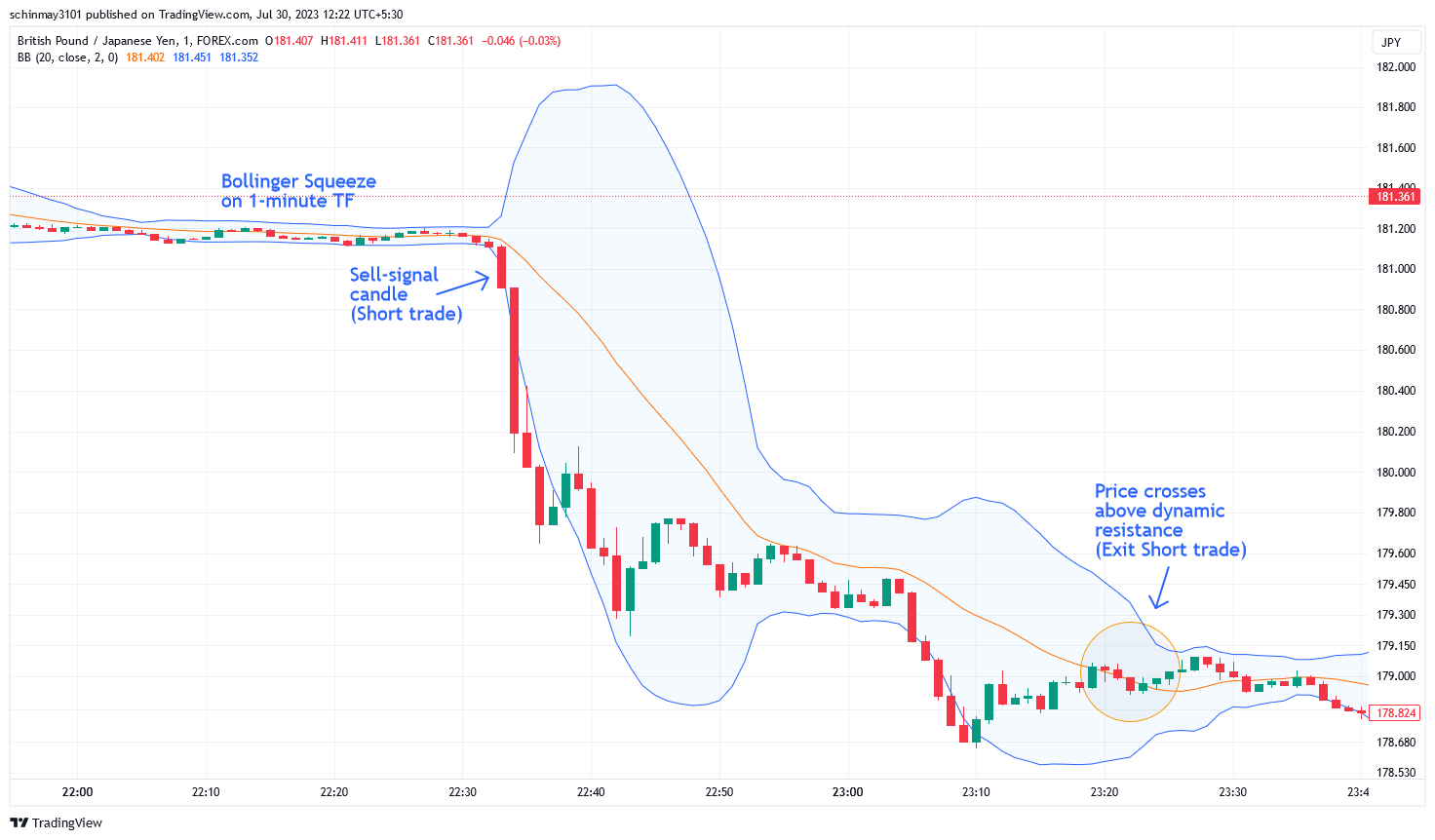
Bollinger Bands Indicator Illustration
Features
Bollinger Bands, a pivotal tool for day trading, consists of three key elements: a central moving average (often a 20-period Simple Moving Average), an upper band (computed by adding twice the standard deviation of price to the moving average), and a lower band (calculated by subtracting twice the standard deviation of price from the moving average). These bands are dynamic, adapting to market volatility by expanding during heightened volatility and contracting during quieter phases. Seasoned day traders generally employ Bollinger bands to spot potential increase in volatility (capitalizing on momentum), and utilize price interactions with the bands to judge potential shifts in the market.
Example (Entry and Exit Points)
Although the traditional Bollinger bands strategy considers the bands as bounce-back levels, day traders often take a contrarian view when using this indicator. After a prolonged level of low volatility (as depicted by a very narrow range of Bollinger bands – termed as the Bollinger squeeze), when the price makes a sudden move towards any direction, a buy/sell signal is generated towards the same direction. Exit signal is generated when the price reverses and touches the dynamic resistance (centre line).
Relative Strength Index (RSI)
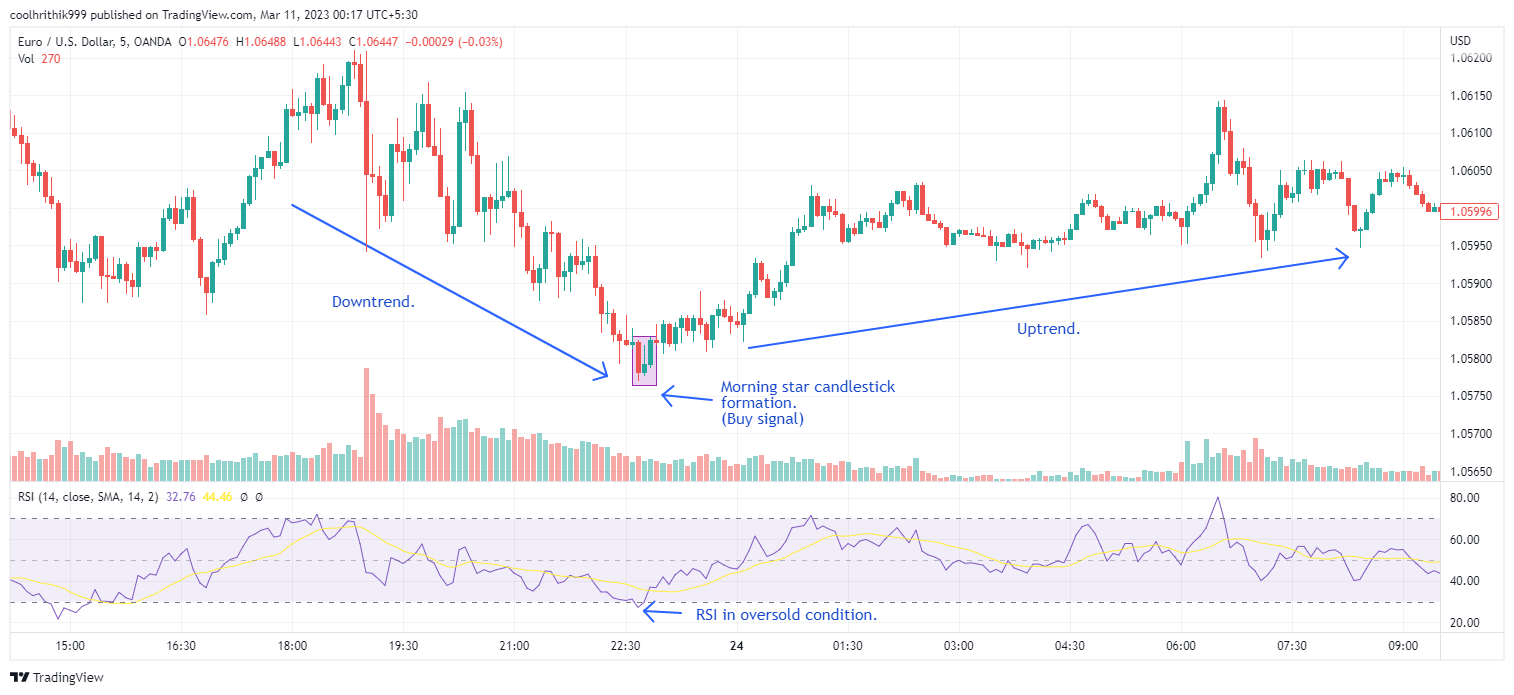
RSI Indicator Illustration
Features
The Relative Strength Index (RSI) is another highly popular indicator among day traders and scalpers. It assesses the magnitude of recent price changes, indicating overbought or oversold conditions within a given time frame. RSI values range from 0 to 100, with readings above 70 typically signalling overbought conditions, and readings below 30 suggesting oversold conditions. This helps traders anticipate potential price reversals or corrections. Moreover, RSI divergence from price movements can determine trend shifts. RSI's adaptability to various time frames makes it a versatile tool for intraday analysis.
Example (Entry and Exit Points)
Buying opportunities arise when RSI breaches the oversold region and touches/crosses below the value of 30, indicating a potential rebound. Conversely, potential selling opportunities are highlighted when RSI breaches the overbought region, crossing/touching above 70, signalling a possible reversal to downtrend. In order to further refine the signals, experts suggest integrating insights provided by RSI with other indicators and comprehensive market analysis, mitigating false signals and optimizing the overall trading strategy.
Ichimoku Clouds
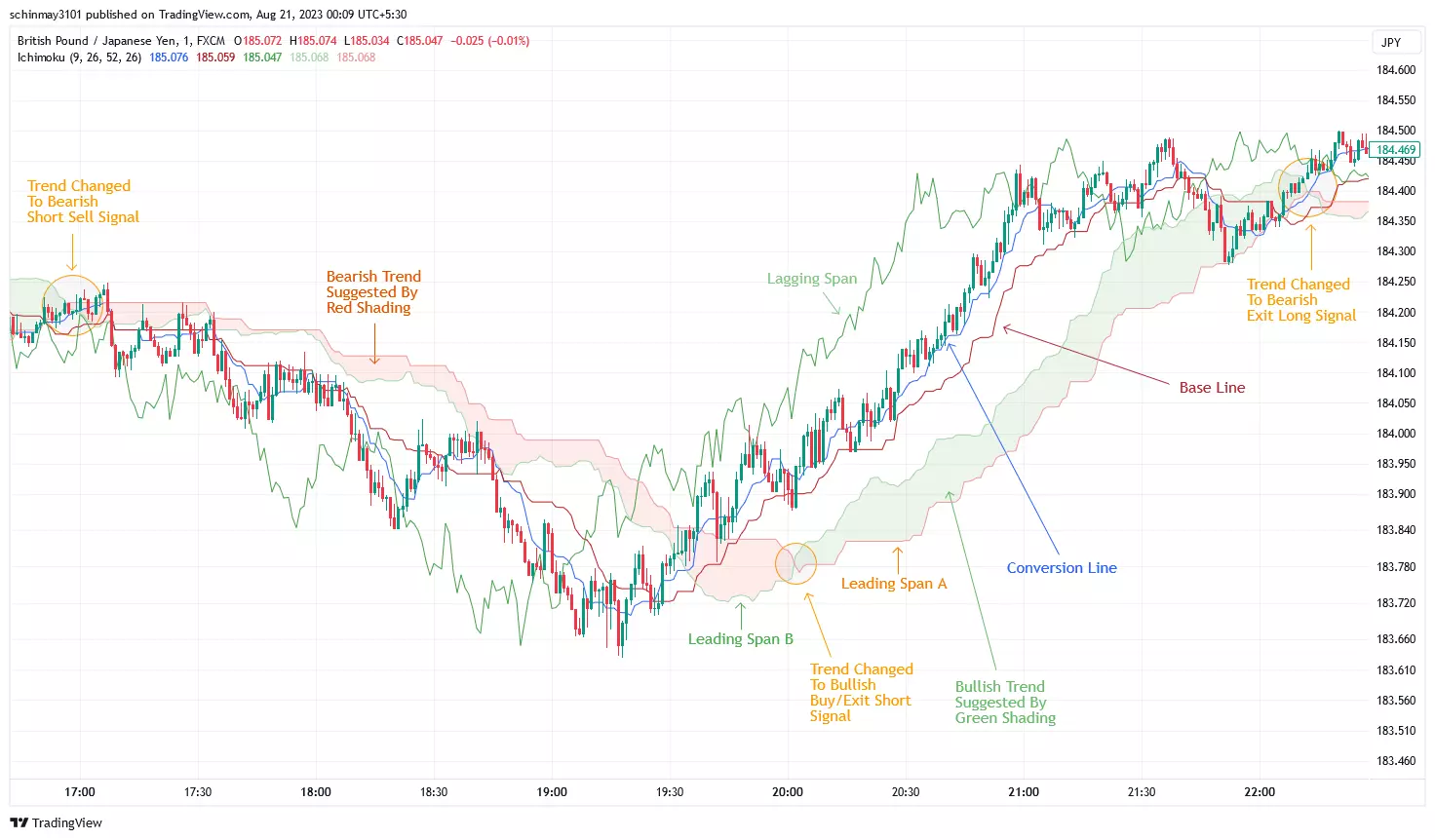
Ichimoku Cloud Indicator Illustration
Features
The Ichimoku Cloud indicator helps traders in judging potential trades by showing trends, support and resistance levels, and momentum. Essentially, this indicator offers a quick way to understand market conditions. The Ichimoku Cloud includes five elements, four of which are based on high and low averages over a period. These elements are Leading Spans A and B, Conversion Line, Base Line, and Lagging Span. The Cloud, created by the interaction between Span A and Span B, predicts future support and resistance levels. The Cloud's color and thickness indicate trend strength and volatility. Lagging Span is a delayed signal that confirms trends and finds support/resistance levels. These parts together give traders a complete picture of price trends, volatility, and possible reversals.
Example (Entry and Exit Points)
In a highly trending market, look for trend reversal signals as suggested by the cloud element of the Ichimoku Cloud indicator. A buy signal is generated when the price crosses above a bearish cloud (red shade) and the trend changes to bullish. Conversely, a sell signal is generated when the price crosses below a bullish cloud (green shade) and the trend changes to bearish. Look for confirmation with Lagging Span being above (below) past prices. Exit signals occur at the next trend reversal, again as suggested by the cloud shades.
Supertrend
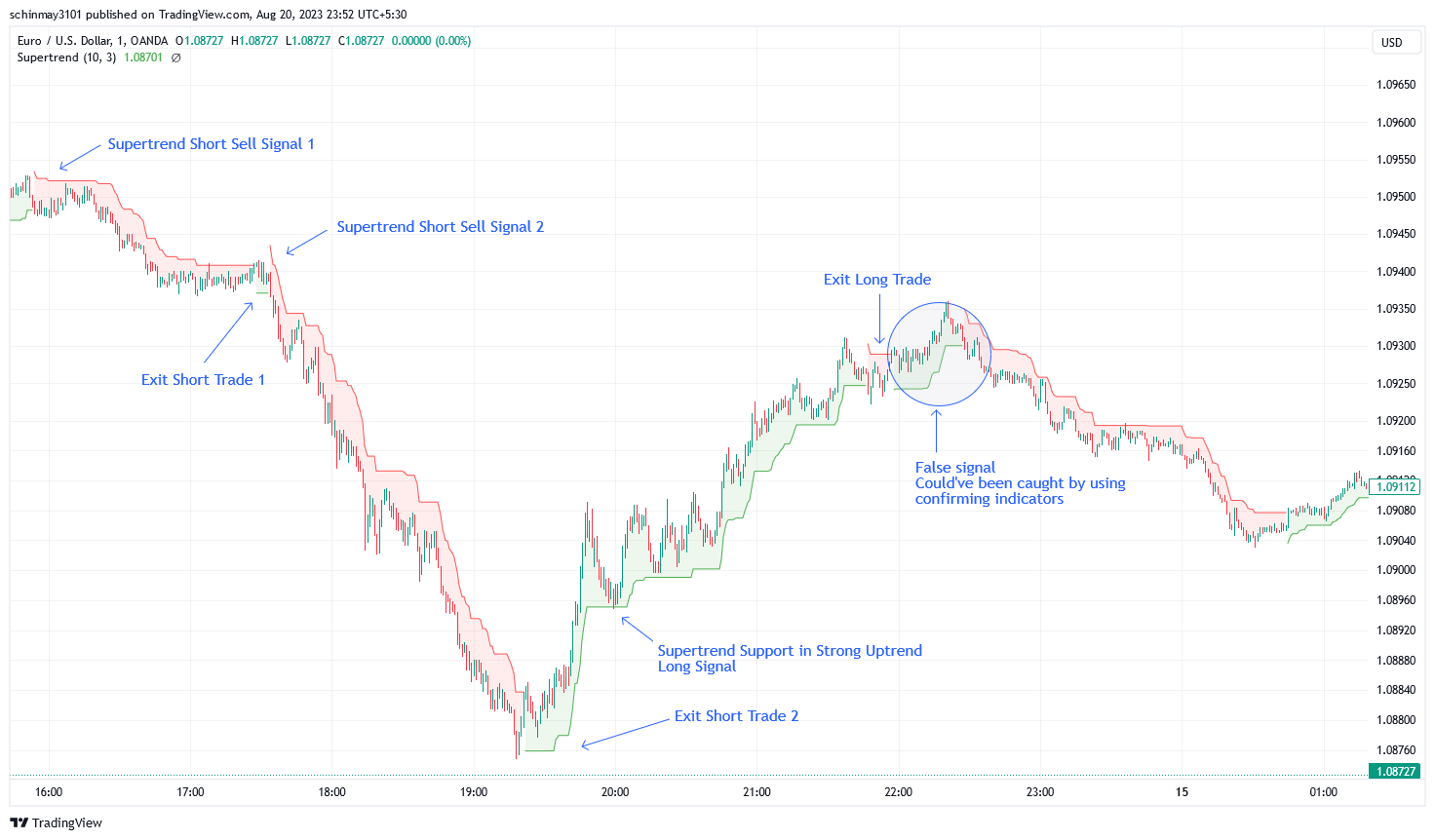
Supertrend Indicator Illustration
Features
Supertrend is essentially a trend-following indicator that helps identify the current market trend and potential entry points. The indicator plots a line above or below the price, based on recent market volatility. When the price crosses this line, it indicates a potential trend change. The indicator is celebrated for the fact that it adjusts to market conditions, offering a dynamic view of trends. Supertrend's simplicity and adaptability make it valuable for traders seeking straightforward trend insights.
Example (Entry and Exit Points)
A price moving above the Supertrend line could signal a potential buy opportunity, as it indicates an upward trend. Conversely, a price moving below the Supertrend line could signal a potential sell opportunity, as it indicates a downtrend. It is important to note that experts suggest using the Supertrend indicator during trending and fast-paced markets, and not in slow-moving range-bound markets, to get the best results.
Best Forex brokers 2024


Volume Weighted Average Price (VWAP)
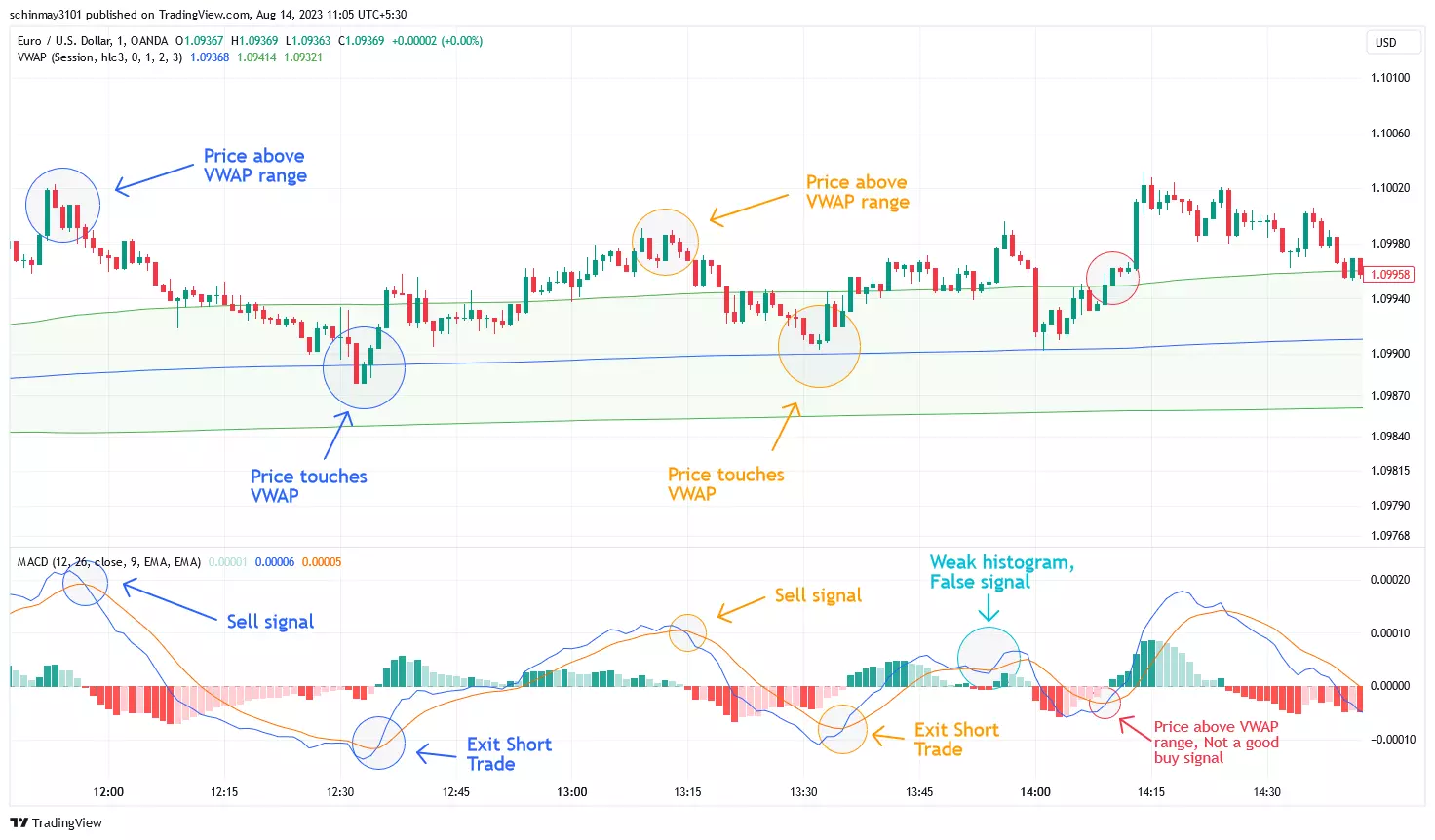
VWAP Indicator Illustration
Features
The Volume-Weighted Average Price (VWAP) is a technical indicator that calculates the average asset price over a certain period, weighting it against the cumulative volume of the security during that time. To find VWAP, you add up the total value of all trades during that time and then divide it by the total number of shares traded. This method gives a more accurate average price than just a regular average. VWAP functions as an execution strategy in algorithmic trading, helping to achieve an improved average price for substantial share volumes over a specific duration. Moreover, VWAP's role in assessing market liquidity is valuable, with higher values denoting more buying and selling activity, and lower values suggesting reduced liquidity.
Example (Entry and Exit Points)
Traditionally, if the current price is lower than the VWAP line, it can be a good time to buy, as you might be getting a better deal than the average price. Conversely, if the current price is higher than the VWAP line, it can be a good time to sell, as the price might be higher than the average. So essentially, VWAP helps you decide when to buy if the price is low compared to the average, and when to sell if the price is high when compared to the average. Combining VWAP with other indicators such as the MACD might reap better results for day traders. A common strategy used is implementing signals generated by MACD while confirming the same with VWAP signals.
Moving Average Convergence Divergence (MACD)
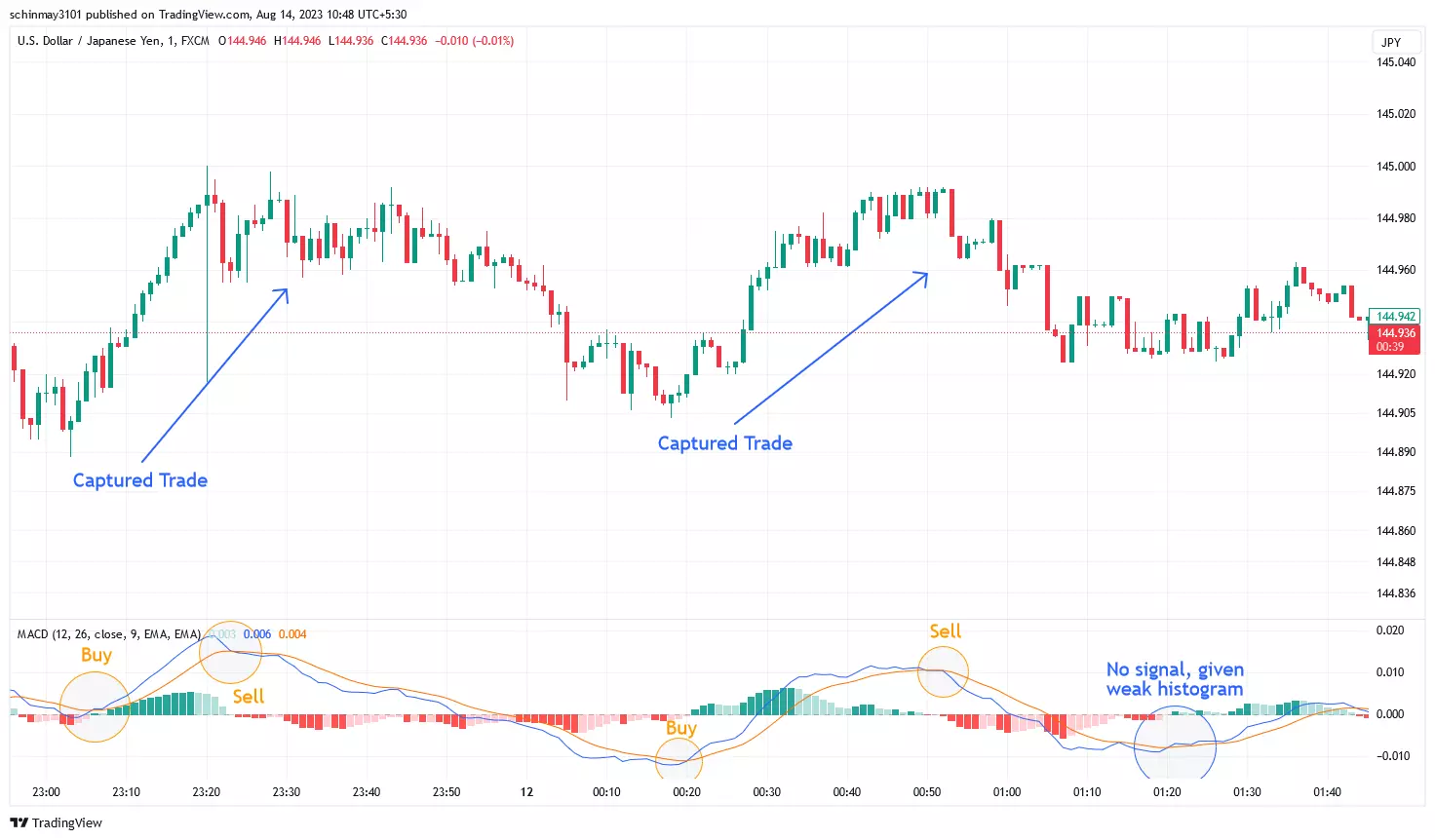
MACD Indicator Illustration
Features
At its core, the MACD indicator shows how strong a trend is and when it might change. It is an oscillator, which means it moves back and forth around a center line. There are mainly three components in the MACD indicator: the MACD line, the signal line, and the histogram. The interactions between the MACD line and the signal line suggest potential trades, while the histogram is used to depict the strength of the signal. As it is based on exponential moving averages, the MACD indicator generates signals that provide insights into the future market movements, and hence it is categorized as a leading indicator.
Example (Entry and Exit Points)
When the MACD line moves above the zero line, it points towards an upward trend, signalling that it is a good time to buy. Conversely, when the MACD line goes below the zero line, it suggests a downward trend, depicted as potentially a good moment to sell. Additionally, a buy signal often occurs when the MACD line crosses above the signal line, while a sell signal is triggered by the MACD line crossing below the signal line. Keep in mind that using MACD signals alongside other indicators can make predictions more accurate, assisting traders in making wise choices during market changes.
Exponential moving average
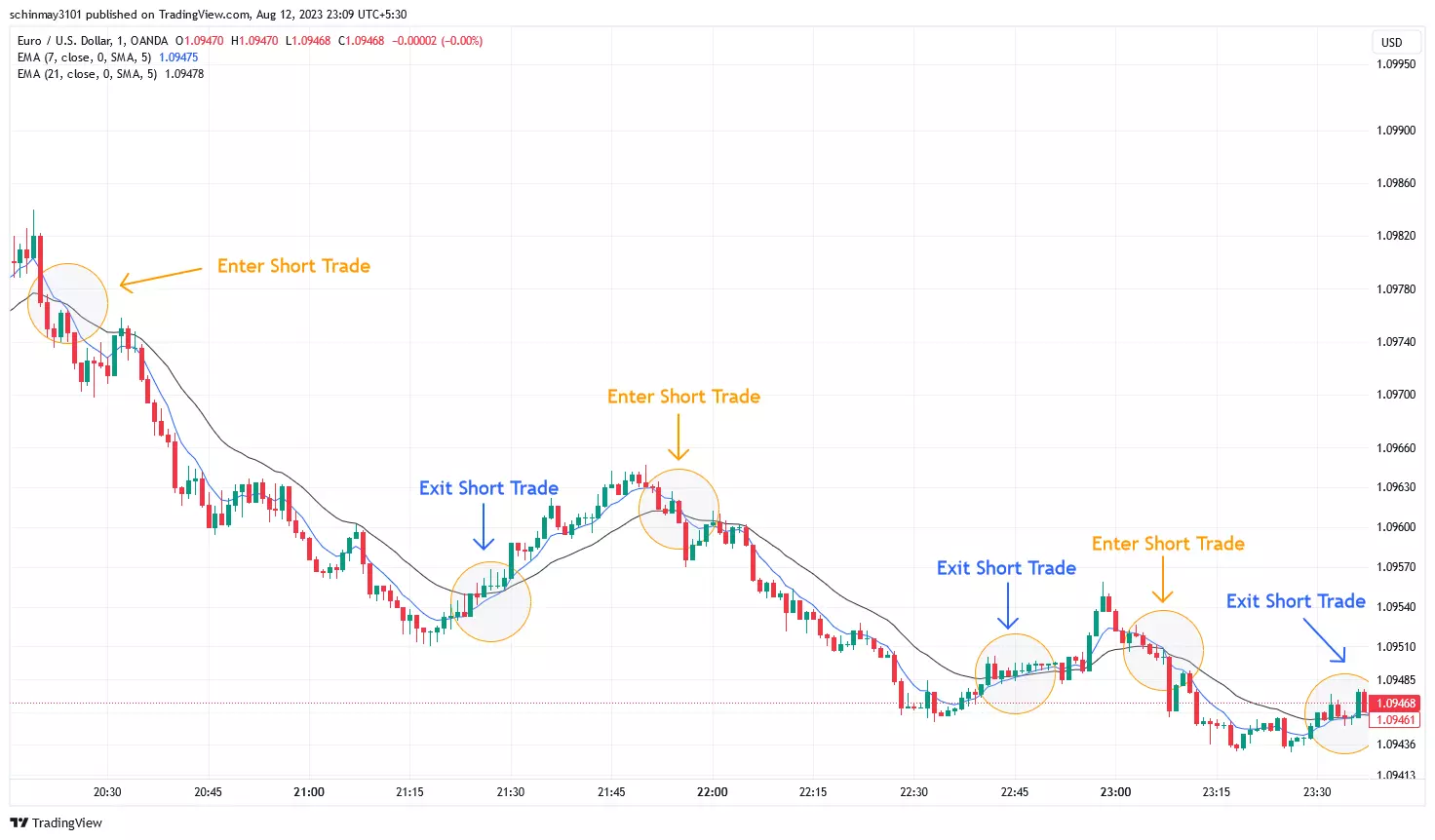
EMA Indicator Illustration
Features
The Exponential Moving Average (EMA) is often employed by day traders and scalpers to take advantage of its dynamic nature. Unlike the Simple Moving Average (SMA), the EMA prioritizes recent price data, making it highly responsive to real-time market fluctuations. This heightened sensitivity aids in the recognition of evolving trends and alterations in prices, which is crucial for making swift decisions within the context of intraday trading. Additionally, the EMA's adaptability across various time frames caters to the rapid pace of day trading, allowing traders to effectively capture short-term movements.
Example (Entry and Exit Points)
Traders commonly watch for shorter EMA crossing above longer EMA as a possible entry sign and a potential bullish trend reversal. On the flip side, to choose when to exit, traders often wait for a reverse crossover (shorter EMA crossing below longer EMA), as it might mean another shift in momentum is coming. To further increase the accuracy of the signals generated by this indicator, experts suggest using EMA by combining it with other indicators that work well together and making a thorough analysis of the market. Doing so may help make the signals more accurate, decrease false alarms, and improve how well your trading strategies work overall.
How to use multiple indicators for day trading and scalping?
In day trading and scalping, employing multiple indicators enhances decision-making by capitalizing on the concept of confluence. Confluence occurs when different indicators confirm a single trading signal, strengthening its reliability. This approach mitigates the risk of false signals and enhances the accuracy of entry and exit points. Imagine combining indicators like MACD, RSI, along with giving due consideration to trading volume. If MACD suggests a change in direction, RSI shows the market might be too high or too low, and volume supports the move, a stronger signal emerges.
Simply put, using indicators that work well together is like teamwork. When they all point to the same thing, it gives you more confidence in your trade. Just like friends agreeing on something makes you more certain, confluence makes your trading decisions more reliable.
Top day trading tips
Experts have outlined the following key tips for day trading enthusiasts:
Plan and prepare
Develop a solid trading plan before you start. Set clear goals, define risk limits, and outline strategies to follow.
Risk management
Only risk a small portion of your capital on each trade. Use stop-loss orders to limit potential losses and protect your account. Learn also the information about how to set take profit (TP) and stop loss (SL) in TradingView.
Practice patience
Wait for high-probability setups that align with your strategy. Avoid impulsive trades driven by emotions.
Focus on liquid assets
Trade in markets with high trading volumes and liquidity to ensure smooth execution of orders. It helps in avoiding hidden transaction costs in the form of wider bid-ask spreads.
Use technical analysis
Check out price charts and special signs that can tell you where things might go with the help of technical indicators.
Learn trading psychology
Keep your cool and don't let fear or wanting more money drive you. Mastering trading psychology is perhaps one of the most important tasks for anyone looking to establish a day trading career.
Summary
TradingView offers a variety of tools for day traders, including Bollinger Bands for volatility trading, RSI for overbought/oversold conditions, EMA for dynamic trend tracking, MACD for momentum, VWAP for average price assessment, Volume Profile for support/resistance zones, and Supertrend for trend following. Combining these indicators enhances decision-making through confluence. Bollinger Bands spot reversals and overbought/oversold conditions. RSI signals trend shifts. EMA's responsiveness aids quick decisions. MACD's crossovers suggest trends. VWAP gauges average price. Volume Profile identifies key levels. And Supertrend signals trends. In all, scalping can be profitable with a solid plan, risk management, patience, liquid assets, technical analysis, emotional control, learning from experience, vigilance, and continuous learning. The confluence of indicators enhances trade reliability.
FAQs
What is the most powerful indicator for day trading?
There's no single "most powerful" indicator for day trading, as effectiveness varies by strategy and market conditions. However, indicators such as RSI, MACD, Supertrend, Ichimoku Cloud, and Bollinger Bands, among others, are widely used for day trading and scalping.
Which indicator has the highest accuracy in TradingView?
Ideally, the accuracy of any indicator inherently depends on the strategy employed by the trader. That being said, among the standard-built indicators available in TradingView, the RSI indicator is widely renowned for its high accuracy.
Which is the most profitable indicator in TradingView?
The profitability of TradingView indicators highly depends on how they are implemented in a trading strategy. However, in their raw form, the MACD and VWAP indicators, when used in confluence, are considered to be highly profitable by seasoned traders.
What is the best indicator for 5 min scalping?
The most suitable indicators for 5-min scalping include the MACD, RSI, Bollinger Bands, and Exponential Moving Averages (EMAs).
Glossary for novice traders
-
1
Broker
A broker is a legal entity or individual that performs as an intermediary when making trades in the financial markets. Private investors cannot trade without a broker, since only brokers can execute trades on the exchanges.
-
2
Trading
Trading involves the act of buying and selling financial assets like stocks, currencies, or commodities with the intention of profiting from market price fluctuations. Traders employ various strategies, analysis techniques, and risk management practices to make informed decisions and optimize their chances of success in the financial markets.
-
3
Day trading
Day trading involves buying and selling financial assets within the same trading day, with the goal of profiting from short-term price fluctuations, and positions are typically not held overnight.
-
4
Scalping
Scalping in trading is a strategy where traders aim to make quick, small profits by executing numerous short-term trades within seconds or minutes, capitalizing on minor price fluctuations.
-
5
Bollinger Bands
Bollinger Bands (BBands) are a technical analysis tool that consists of three lines: a middle moving average and two outer bands that are typically set at a standard deviation away from the moving average. These bands help traders visualize potential price volatility and identify overbought or oversold conditions in the market.
Team that worked on the article
Chinmay Soni is a financial analyst with more than 5 years of experience in working with stocks, Forex, derivatives, and other assets. As a founder of a boutique research firm and an active researcher, he covers various industries and fields, providing insights backed by statistical data. He is also an educator in the field of finance and technology.
As an author for Traders Union, he contributes his deep analytical insights on various topics, taking into account various aspects.
Dr. BJ Johnson is a PhD in English Language and an editor with over 15 years of experience. He earned his degree in English Language in the U.S and the UK. In 2020, Dr. Johnson joined the Traders Union team. Since then, he has created over 100 exclusive articles and edited over 300 articles of other authors.
Mirjan Hipolito is a journalist and news editor at Traders Union. She is an expert crypto writer with five years of experience in the financial markets. Her specialties are daily market news, price predictions, and Initial Coin Offerings (ICO).






